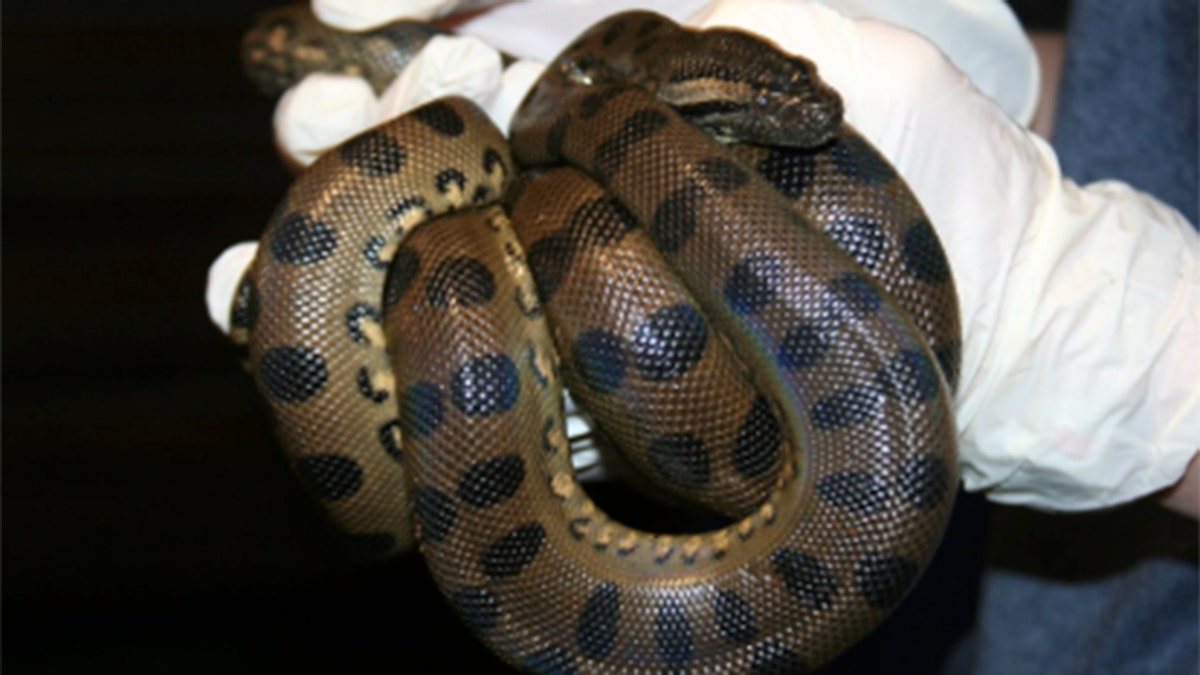Fox News Flash top headlines for May 24
Fox News Flash top headlines for May 24 are here. Check out what's clicking on FoxNews.com
A female anaconda gave birth without the help of a male, according to the Massachusetts aquarium where it happened.
Anna, an 8-year-old anaconda at the New England Aquarium in Boston, used the extremely rare reproductive strategy called parthenogenesis, which resulted in two living baby anacondas, a press release from the aquarium said.
GEORGIA FAMILY FINDS MASSIVE ALLIGATOR ‘SUNNING HIMSELF’ IN FRONT YARD
The 10-foot, 30-pound snake is kept in an all-female exhibit, so when aquarium staff found Anna in the process of delivering her litter in January, they suspected it was parthenogenesis -- which means “virgin birth” in Greek according to the release -- though they had to rule out other possibilities.
“This is the product of a very unusual process that we needed to go through testing to confirm what we were suspecting,” aquarium spokesman Tony LaCasse told The Boston Globe.
The other two female anacondas in the exhibit were checked to reconfirm their gender and then Anna’s history was double-checked to confirm she hadn’t been exposed to a male and her babies were a result of delayed embryo implantation, the release said.

An 8-year-old anaconda at the New England Aquarium gave birth without the help of a male, a rare reproductive process called parthenogenesis. Only two of her litter survived past the first few days. (New England Aquarium)
After those options were eliminated, the baby snakes had tissue samples sent off for DNA analysis.
“Many weeks later, the results acknowledged what most Aquarium staff had suspected that Anna had reproduced nonsexually, or by parthenogenesis, which also occurs in the wild,” the release said.
“It’s a little bit of excitement in terms of the birth, but also one of success because the mystery was solved,” LaCasse told The Globe.
Though some offspring of parthenogenesis can have different DNA from their mother, Anna’s two surviving babies showed “complete matches on all the sites tested,” the release said, adding: “These two young appear to be genetic copies or clones of the mother.”
HUGE RAT SNAKES FIGHT OVER FEMALE IN NORTH CAROLINA, RARE VIDEO SHOWS
“Parthenogenesis is much more common in the plant and insect worlds,” the release explained. “This process, which allows a female organism to replicate itself without fertilization from a male, is extremely rare among vertebrate species or animals without a backbone.”
This is only the second confirmed case of parthenogenesis in a green anaconda. The other case happened in a United Kingdom zoo in 2014.

DNA analysis confirmed that the two young snakes "appear to be genetic copies or clones of the mother," a press release said. (New England Aquarium)
Though Anna delivered several young in her litter, many were stillborn and a third newborn died several days after it was born.
The other two, which are now 2 feet long, are thriving according to the release. Staff members have even noticed their differing personalities. The thinner anaconda is “laid back” and the heavier one is “more apt to explore,” the release said.
They aren’t on exhibit yet but are being cared for and handled behind the scenes.
CLICK HERE FOR THE FOX NEWS APP
“The more they’re habituated to handling, the better we’re able to handle them, especially when they’re adults,” LaCasse told The Globe. “They’re currently very popular with our staff because they’re really taking to being handled.”

